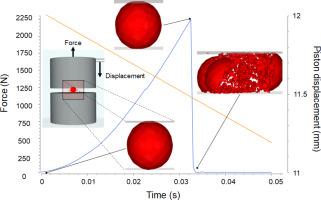利用离散破碎模型模拟铁矿球团的压缩破碎
IF 4.5
2区 工程技术
Q2 ENGINEERING, CHEMICAL
引用次数: 0
摘要
近年来,离散元法 (DEM) 中嵌入的断裂模拟有了长足的发展,既利用了更强的计算能力,也利用了商业和开源软件包中可用的新方法。这项工作详细分析了使用商业软件 Ansys Rocky 中的离散破损模型 (DBM) 模拟破损的情况。研究了铁矿球团在缓慢压缩条件下的破损情况。在为被描述为多面体颗粒的球团选择合适的接触参数后,该模型用于描述球团的破碎,从模拟开始就考虑了完全解析的碎片。分析了接触模型、时间步长和元素数量对模型表示压缩下铁矿球团平均破碎响应能力的影响。然后使用一种方法来解释球团破裂特性的变化,这种方法在应用于另一种球团样本时提供了有效的描述,当应用于不同尺寸的球团时,也显示出描述尺寸尺度对球团破裂能量影响的能力。本文章由计算机程序翻译,如有差异,请以英文原文为准。

Simulating breakage by compression of iron ore pellets using the discrete breakage model
Simulation of breakage embedded in the discrete element method (DEM) has evolved significantly in recent years, taking advantage of both greater computing power and novel approaches that have become available in both commercial and open-source packages. This work analyzes in detail the simulation of breakage using the discrete breakage model (DBM) in the commercial software Ansys Rocky. Breakage of iron ore pellets under slow compression was studied. After the selection of suitable contact parameters for the pellets, described as polyhedral particles, the model is used to describe their breakage considering fully resolved fragments from the beginning of the simulation. The effects of contact model, time step and number of elements on the ability of the model to represent average breakage response of iron ore pellets under compression is analyzed. An approach was then used to account for the variability in the breakage characteristics of the pellets, which provided a valid description when applied to another pellet sample, also showing capability to describe the size-scale effect on the breakage energy of pellets when applied to pellets of different sizes.
求助全文
通过发布文献求助,成功后即可免费获取论文全文。
去求助
来源期刊

Powder Technology
工程技术-工程:化工
CiteScore
9.90
自引率
15.40%
发文量
1047
审稿时长
46 days
期刊介绍:
Powder Technology is an International Journal on the Science and Technology of Wet and Dry Particulate Systems. Powder Technology publishes papers on all aspects of the formation of particles and their characterisation and on the study of systems containing particulate solids. No limitation is imposed on the size of the particles, which may range from nanometre scale, as in pigments or aerosols, to that of mined or quarried materials. The following list of topics is not intended to be comprehensive, but rather to indicate typical subjects which fall within the scope of the journal's interests:
Formation and synthesis of particles by precipitation and other methods.
Modification of particles by agglomeration, coating, comminution and attrition.
Characterisation of the size, shape, surface area, pore structure and strength of particles and agglomerates (including the origins and effects of inter particle forces).
Packing, failure, flow and permeability of assemblies of particles.
Particle-particle interactions and suspension rheology.
Handling and processing operations such as slurry flow, fluidization, pneumatic conveying.
Interactions between particles and their environment, including delivery of particulate products to the body.
Applications of particle technology in production of pharmaceuticals, chemicals, foods, pigments, structural, and functional materials and in environmental and energy related matters.
For materials-oriented contributions we are looking for articles revealing the effect of particle/powder characteristics (size, morphology and composition, in that order) on material performance or functionality and, ideally, comparison to any industrial standard.
 求助内容:
求助内容: 应助结果提醒方式:
应助结果提醒方式:


